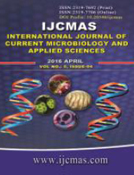


 National Academy of Agricultural Sciences (NAAS)
National Academy of Agricultural Sciences (NAAS)

|
PRINT ISSN : 2319-7692
Online ISSN : 2319-7706 Issues : 12 per year Publisher : Excellent Publishers Email : editorijcmas@gmail.com / submit@ijcmas.com Editor-in-chief: Dr.M.Prakash Index Copernicus ICV 2018: 95.39 NAAS RATING 2020: 5.38 |
This study was conducted in R&D department, Kenana Sugar Company, Sudan on June 2014 and January 2015, to treat the sugar and alcohol industry waste as a source of biomass converted into alternative renewable energy as a biogas from the mixing of Vinasse, wastewater and filter mud using anaerobic digestion process and rumen fluids as inoculum starter for 28 working days at room temperature. Experiments were carried out to find optimum condition and parameters of biogas production process, Substrates (Vinasse: filter mud: wastewater) were mixed into three different ratios A (1:3:1), B (2:2:1), C (3:1:1) experiments were conducted in summer and winter. In summer (A, TS=12.07a, COD=89.10a, Biogas yield=1718.3ml/l, B, TS=8.96ab, COD=55.30a, Biogas yield=1751.7ml/l, C, TS=5.9, COD=82.3, Biogas yield=2470ml/l). C had the highest biogas production and COD removal rate in summer. In winter (A, TS=13.16b, COD=119.66a, Biogas yield=2514.7ml/l, B, TS=15.96a, COD=18.28b, Biogas yield=2335.0ml/l, C, TS=10.3, COD=72, Biogas yield=2265ml/l). A had the highest biogas production and COD removal rate in winter. So the average of biogas yields in summer 1777ml/l, 2371ml/l in winter, both 2070 ml/l yield/year. That means 3752*106 m3/year of waste produce 7766*105 m3/year of biogas that equal 4660*105 kWh, also reduce odor, organic load, produce better fertilizer, minimize waste treating cost, power saving and less polluting. Results showed not significant different in biogas production and COD removal rate in summer and winter. Study concluded that utilization of mixed biomass derived from sugar industry byproducts and wastewaters for biogas production is applicable and feasible.
 |
 |
 |
 |
 |